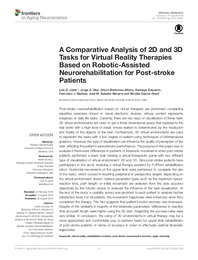Por favor, use este identificador para citar o enlazar este ítem:
https://hdl.handle.net/11000/31251Registro completo de metadatos
| Campo DC | Valor | Lengua/Idioma |
|---|---|---|
| dc.contributor.author | Badesa, Francisco J. | - |
| dc.contributor.author | García Aracil, Nicolás | - |
| dc.contributor.author | Ezquerro, Santiago | - |
| dc.contributor.author | Sabater Navarro, José M. | - |
| dc.contributor.author | Bertomeu Motos, Arturo | - |
| dc.contributor.author | Lledó, Luis D. | - |
| dc.contributor.author | Díez, Jorge A. | - |
| dc.contributor.other | Departamentos de la UMH::Ingeniería de Sistemas y Automática | es_ES |
| dc.date.accessioned | 2024-02-07T17:52:21Z | - |
| dc.date.available | 2024-02-07T17:52:21Z | - |
| dc.date.created | 2016 | - |
| dc.identifier.citation | Frontiers in Aging Neuroscience Volume 8 - 2016 | es_ES |
| dc.identifier.issn | 1663-4365 | - |
| dc.identifier.uri | https://hdl.handle.net/11000/31251 | - |
| dc.description.abstract | Post-stroke neurorehabilitation based on virtual therapies are performed completing repetitive exercises shown in visual electronic devices, whose content represents imaginary or daily life tasks. Currently, there are two ways of visualization of these task. 3D virtual environments are used to get a three dimensional space that represents the real world with a high level of detail, whose realism is determinated by the resolucion and fidelity of the objects of the task. Furthermore, 2D virtual environments are used to represent the tasks with a low degree of realism using techniques of bidimensional graphics. However, the type of visualization can influence the quality of perception of the task, affecting the patient's sensorimotor performance. The purpose of this paper was to evaluate if there were differences in patterns of kinematic movements when post-stroke patients performed a reach task viewing a virtual therapeutic game with two different type of visualization of virtual environment: 2D and 3D. Nine post-stroke patients have participated in the study receiving a virtual therapy assisted by PUPArm rehabilitation robot. Horizontal movements of the upper limb were performed to complete the aim of the tasks, which consist in reaching peripheral or perspective targets depending on the virtual environment shown. Various parameter types such as the maximum speed, reaction time, path length, or initial movement are analyzed from the data acquired objectively by the robotic device to evaluate the influence of the task visualization. At the end of the study, a usability survey was provided to each patient to analysis his/her satisfaction level. For all patients, the movement trajectories were enhanced when they completed the therapy. This fact suggests that patient's motor recovery was increased. Despite of the similarity in majority of the kinematic parameters, differences in reaction time and path length were higher using the 3D task. Regarding the success rates were very similar. In conclusion, the using of 2D environments in virtual therapy may be a more appropriate and comfortable way to perform tasks for upper limb rehabilitation of post-stroke patients, in terms of accuracy in order to effectuate optimal kinematic trajectories. | es_ES |
| dc.format | application/pdf | es_ES |
| dc.format.extent | 16 | es_ES |
| dc.language.iso | eng | es_ES |
| dc.publisher | Frontiers Media | es_ES |
| dc.rights | info:eu-repo/semantics/openAccess | es_ES |
| dc.rights | Attribution-NonCommercial-NoDerivatives 4.0 Internacional | * |
| dc.rights.uri | http://creativecommons.org/licenses/by-nc-nd/4.0/ | * |
| dc.subject | virtual reality | es_ES |
| dc.subject | rehabilitation robotics | es_ES |
| dc.subject | post-stroke | es_ES |
| dc.subject | sensorimotor function | es_ES |
| dc.subject | upper extremity | es_ES |
| dc.subject.other | CDU::0 - Generalidades.::04 - Ciencia y tecnología de los ordenadores. Informática. | es_ES |
| dc.title | A Comparative Analysis of 2D and 3D Tasks for Virtual Reality Therapies Based on Robotic-Assisted Neurorehabilitation for Post-stroke Patients | es_ES |
| dc.type | info:eu-repo/semantics/article | es_ES |
| dc.relation.publisherversion | https://doi.org/10.3389/fnagi.2016.00205 | es_ES |

Ver/Abrir:
2016_frontiers.pdf
4,45 MB
Adobe PDF
Compartir:
 La licencia se describe como: Atribución-NonComercial-NoDerivada 4.0 Internacional.
La licencia se describe como: Atribución-NonComercial-NoDerivada 4.0 Internacional.
.png)